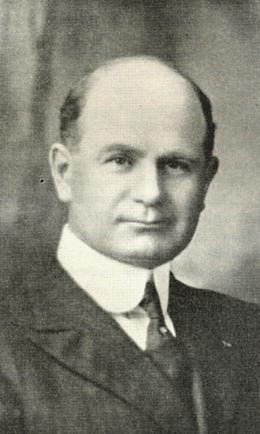George Watkin Evans was a pioneering mining engineer in Washington who spent much of his career studying and documenting the state's coal-mining industry. This People's History of Evans's life and work was contributed by William Kombol, Manager of the Palmer Coking Coal Company in Black Diamond.
Born To the Mines
"Son," he said, picking up a lump of coal, "here is imprisoned sunshine that warmed a swamp which stood here millions of years ago." So spoke a Washington state coal-mine inspector to the 17-year-old George Watkin Evans, who started working at the Franklin coal mines on January 9, 1888. Evans went on to probably know more about coal mining in the Pacific Northwest than any other then-living person. He was an internationally renowned consulting mining engineer who spent most of his remarkable career in the coal fields of Washington.
Evans was born in Abercarne, Wales, on March 5, 1876, to Watkin Evans and Catherine (Hughes). His father was employed as a coal miner there. The family emigrated to the U.S. in 1880, settling first in Shamokin, Pennsylvania, where his father found work in the anthracite fields. The family moved to Franklin, Washington, in 1887, and early the next year young George began his mining career as an 11-year-old oiler, lubricating coal-car wheels. Within a year he was driving the mules that pulled the coal cars, and he went on to learn most of the underground coal-mining jobs.
Learning All About Coal
Evans was at the Franklin mine during the disaster of August 1894 when 37 miners perished from suffocation and smoke. It was about this time that he had his famous encounter with the coal mine inspector -- an event that was to change his life. Evans told a biographer that the phrase "Imprisoned Sunshine!" had set him forth on a hunt for knowledge that continued throughout his life. Evans had no formal schooling as a lad, but taught himself to read the Welsh Bible. The superintendent of the Franklin mine made out a list of books for him to read. Evans said,
"The wonders of coal as revealed in those books filled me with enthusiasm, and with a keen hunger to know all there was to know about coal. I began to live in the Paleozoic age — and to study nights" (Gentlemen Unafraid).
He borrowed books and took correspondence courses as preparatory education to enter Washington State College. He graduated in 1903 with a Bachelor of Science degree as an Engineer of Mines, having earned part of his tuition working in Colorado cyanide mines.
In the early days of the 1897 Klondike gold rush, Mr. Evans, then 21, was part of a geologic survey that clambered over the well-known Chilkoot Pass. But the quest for the yellow metal was not his passion, and his interest turned to "black diamonds." Back in Washington, Evans made his living as a professional civil engineer. He again traveled to Alaska in 1906 to investigate the Bering coal field for the Guggenheim family. In 1909 he was made geologist in charge of coal investigations for the Washington Geological Survey and wrote the authoritative "Bulletin No. 3: The Coal Fields of King County" in 1912.
A Distinguished Career
Evans examined the Matanuska, Alaska, coal field for the Navy in 1913. During the years of World War I, he served as district mining engineer for the U.S. Bureau of Mines. He went on to work for some of the biggest coal mining companies in Washington, including Northern Pacific Railroad, and the Pacific Coast, Carbon Hill, and Hyde coal companies. He maintained his office at the Smith Tower, Seattle's skyscraper of its day. There, Evans wrote countless papers, studies, and reports on coal mines and prospects, many of which are still referenced today due to their completeness and accuracy.
Evans stood over six feet in height and was described as a man of splendid bearing and physique, with a beautiful tenor voice which he used to sing the songs of his native Wales. In 1929, perhaps in appreciation for his work, the Pacific Coast Coal Company sold him 1.5 acres of land above the Green River, in the town of his youth -- Franklin.
On March 12, 1902 in Garfield, Washington, Evans was married to Olivia L. Laird, a daughter of Samuel T. and Elizabeth Laird. They met while in college at Pullman. The couple had had three children: Watkin L. Evans, Blodwen E. Evans, and Lloyd George Evans. He was a 32nd degree Mason, a Noble of the Mystic Shrine, and supported the Republican Party. Professionally he was associated with the American Institute of Mining Engineers and the National Geographic Society. Locally, he was a member of the Arctic Club of Seattle and the Rotary.
George Watkin Evans lived in Seattle most of his adult life and passed away on January 11, 1951 at the age of 74. Olivia Laird Evans died in December 1965.

